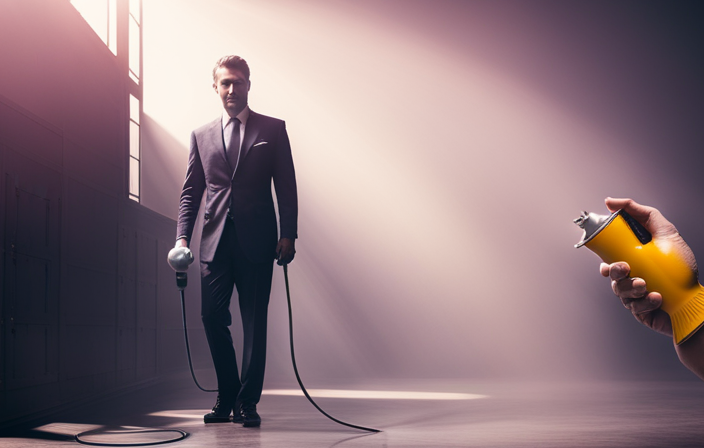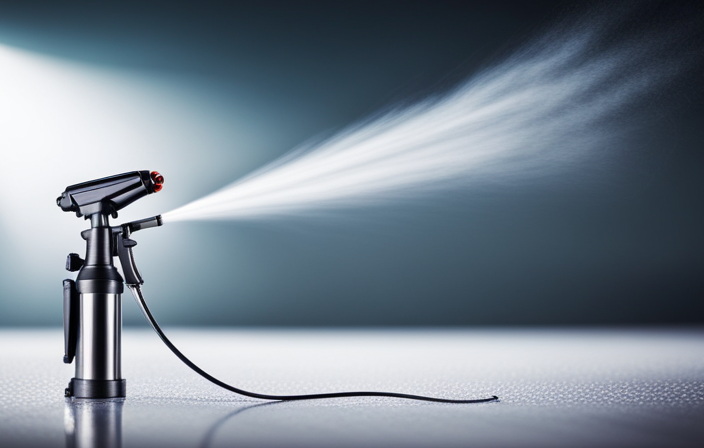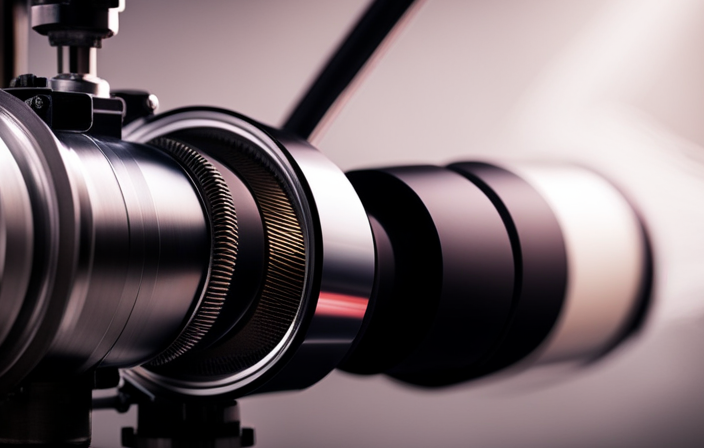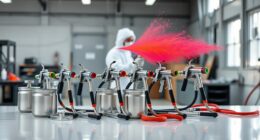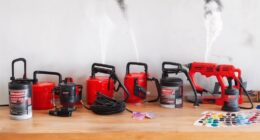You have just purchased an airless sprayer and are eager to start painting. However, you’ve encountered a problem – your latex paint is too thick for spraying smoothly. Fear not, I have a solution for you.
In this article, I’m going to show you exactly how to thin that latex paint for your airless sprayer like a pro.
Thinning latex paint is a crucial step when it comes to using an airless sprayer. It helps ensure a smooth and even application, preventing clogs and drips that can ruin your hard work. But don’t fret, it’s not as complicated as it may seem.
I’ll guide you through the process, step by step, from gathering the necessary tools and materials to determining the proper consistency for thinning your paint. We’ll even test it to make sure it’s just right before loading it into the sprayer.
So grab your paintbrush and let’s get started on thinning that latex paint for your airless sprayer. You’ll be painting like a pro in no time.
Key Takeaways
- Thinning latex paint before using an airless sprayer helps to achieve consistent spray patterns and prevent clogs.
- It is important to follow the recommended level for filling the sprayer to avoid spills and wasted paint.
- Thoroughly mixing thinned paint ensures consistent color and texture for a professional finish.
- Cleaning and maintaining the airless sprayer after use is crucial for its longevity and optimal performance.
Understand the Importance of Thinning Latex Paint for Airless Sprayers
To properly utilize your airless sprayer, you must understand the significance of thinning latex paint. Thinning the paint is essential because it allows for a smoother and more even application. The viscosity of latex paint is typically too high for airless sprayers, which can lead to clogging and an uneven finish. By thinning the paint, you reduce the risk of these issues and ensure a professional-looking result.
Additionally, using an airless sprayer for painting has numerous benefits, such as faster application, reduced overspray, and the ability to cover large areas in less time. These advantages make it an ideal choice for both professionals and DIY enthusiasts.
Now that we understand the importance of thinning latex paint and the benefits of using an airless sprayer, let’s move on to gathering the necessary tools and materials for the job.
Gather the Necessary Tools and Materials
First, you’ll need a trusty bucket for mixing, a stirring stick for blending, and a measuring cup to ensure the perfect consistency. Choosing the right paint thinner is crucial for thinning latex paint for airless sprayers. It is recommended to use water-based paint thinners specifically designed for latex paints. These thinners are readily available at most hardware stores and can help achieve a smooth finish. When selecting a paint thinner, be sure to check the manufacturer’s instructions for compatibility with latex paint. Additionally, here are some tips for achieving a smooth finish: 1) Start with a small amount of paint thinner and gradually add more if needed. 2) Stir the paint thoroughly to ensure the thinner is evenly distributed. 3) Test the consistency by running the paint through the sprayer and adjusting as necessary. With the right tools and paint thinner, you’ll be on your way to achieving a professional-looking finish. Moving on to the next section, let’s determine the proper consistency for thinning latex paint.
Determine the Proper Consistency for Thinning Latex Paint
Once you’ve gathered the necessary tools and materials, it’s essential to ascertain the proper consistency for thinning the latex paint. Achieving the correct texture is crucial for ensuring a smooth and even application with your airless sprayer.
To determine the proper consistency, you can follow a few tried and tested techniques. One method is to stir the paint thoroughly and then lift the stirring stick out of the paint. If the paint runs off the stick smoothly without any clumps or lumps, it’s likely too thin and may require less thinning. On the other hand, if the paint drips off the stick in thick clumps, it’s too thick and will need more thinning.
This way, you can gauge the appropriate texture before moving on to measure and mix the paint thinner and latex paint, which we’ll cover in the subsequent section.
Measure and Mix the Paint Thinner and Latex Paint
Now, it’s time to accurately measure and blend the paint thinner and latex paint, creating the perfect combination for a flawless application. Achieving the proper consistency is crucial for a smooth and even finish. To ensure accuracy, use measuring cups or a scale to measure both the paint thinner and latex paint. The recommended ratio is usually one part paint thinner to three parts latex paint, but always refer to the manufacturer’s instructions for the specific product you are using. Once the measurements are precise, pour the paint thinner into a container, followed by the latex paint. Use a stir stick or a paint mixer attachment on a drill to thoroughly mix the two components together. This blending process will result in a consistent mixture that is ready for spraying. Transitioning into the next section, it is important to test the thinned paint for proper consistency before proceeding.
Test the Thinned Paint for Proper Consistency
Imagine yourself as a skilled artist, delicately testing the thinned paint with the gentle strokes of a feather, seeking the elusive balance between viscosity and flow. As a seasoned professional, I know the importance of testing the thinned paint before loading it into the airless sprayer.
There are several testing methods that can help ensure the proper consistency. One method is to dip a paint stir stick into the thinned paint and observe how it drips off the stick. Ideally, it should flow evenly, neither too thick nor too watery.
Another method is to spray a small amount of the thinned paint onto a scrap surface and observe the coverage and atomization. Troubleshooting tips include adjusting the paint thinner-to-paint ratio or adding a small amount of water to achieve the desired consistency.
With these testing methods and troubleshooting tips, you can confidently move on to the next step of adjusting the thinned paint as needed for your airless sprayer.
Adjust the Thinned Paint as Needed
To get the perfect consistency, you’ll want to make sure you adjust the thinned paint as needed for your project. When thinning latex paint for an airless sprayer, it’s essential to achieve the right viscosity to ensure smooth and even coverage. If the paint is too thick, it can clog the sprayer nozzle and result in an uneven finish. On the other hand, if the paint is too thin, it may splatter and create a messy application. To adjust the paint viscosity, refer to the manufacturer’s instructions for the recommended thinning ratio. Use a 3 column and 5 row table to keep track of the paint and thinner measurements. Troubleshoot any thinning issues by adding small amounts of water or paint thinner until the desired consistency is achieved. With the thinned paint properly adjusted, you’re now ready to prepare the airless sprayer for painting.
Prepare the Airless Sprayer for Painting
Get your airless sprayer prepped and primed for flawless painting like a pro. To ensure the best results, follow these steps to prepare the airless sprayer for painting:
-
Clean the sprayer: Before starting, make sure to clean the sprayer thoroughly. Remove any old paint or debris that may affect the performance.
-
Check the nozzle: Inspect the nozzle for any clogs or blockages. Clean or replace it if necessary to ensure an even spray pattern.
-
Adjust the pressure: Set the pressure according to the manufacturer’s instructions. This’ll help prevent overspray or uneven application.
-
Test the sprayer: Before painting your surface, test the sprayer on a scrap piece of material. This’ll allow you to troubleshoot any common airless sprayer issues and make adjustments if needed.
Once you’ve prepared your airless sprayer, you’re ready to load the thinned latex paint into the sprayer and start painting with confidence.
Load the Thinned Latex Paint into the Sprayer
Once the airless sprayer is prepped and primed, it’s time to load in the thinned paint and start painting like a pro. Loading the thinned latex paint into the sprayer requires precision and attention to detail. To ensure a smooth and even coverage, avoid these common mistakes when loading paint into an airless sprayer:
-
Pouring paint directly into the sprayer without straining it first can result in clogs and uneven spray patterns. Always strain the paint to remove any impurities or clumps.
-
Overfilling the sprayer can lead to messy spills and wasted paint. Fill the sprayer only to the recommended level, usually marked on the container or in the sprayer’s manual.
-
Neglecting to mix the thinned paint thoroughly can result in inconsistent color and texture. Use a mixing stick or paddle to blend the paint until it’s smooth and uniform.
To achieve smooth and even coverage with thinned latex paint, follow these tips:
-
Start with a low pressure setting on the sprayer and gradually increase it until you achieve the desired spray pattern. This will help prevent overspray and drips.
-
Keep the sprayer moving at a consistent speed and distance from the surface. This will ensure even coverage and prevent buildup in certain areas.
-
Apply multiple thin coats rather than one thick coat. This will help avoid drips and ensure a more professional finish.
In the next section, we will discuss how to practice proper painting techniques with the airless sprayer to achieve flawless results.
Practice Proper Painting Techniques with the Airless Sprayer
Master the art of using the powerful spray machine and achieve flawless results. Here are three proper spraying techniques to ensure a smooth and professional finish with your airless sprayer:
-
Maintain a consistent distance: Keep the sprayer tip approximately 12 inches away from the surface being painted. This ensures an even coat and avoids excessive buildup or drips.
-
Overlap each stroke: When moving the sprayer across the surface, overlap each stroke by about 50%. This helps to prevent streaks and ensures consistent coverage.
-
Practice a steady motion: Move the sprayer in a smooth, steady motion to maintain a uniform application. Avoid stopping or hesitating in one spot, as this can lead to uneven coverage.
By mastering these proper spraying techniques, you can troubleshoot common painting issues such as streaking or unevenness, and achieve professional-looking results.
Transitioning into the subsequent section, it’s essential to clean and maintain the airless sprayer after use to prolong its lifespan and ensure optimal performance.
Clean and Maintain the Airless Sprayer After Use
Now that we have discussed the importance of practicing proper painting techniques with the airless sprayer, let’s shift our focus to the crucial step of cleaning and maintaining the equipment after use. Cleaning the airless sprayer is an essential part of the painting process as it ensures the longevity and optimal performance of the machine.
To guide you through the cleaning process, I have prepared a comprehensive table that highlights the necessary steps and materials required. This table will help you troubleshoot common issues that may arise during the cleaning process, enabling you to address them effectively.
By dedicating time and attention to cleaning and maintenance, you can prolong the lifespan of your airless sprayer and achieve consistent, high-quality results with every paint job. Let’s dive into the cleaning process and troubleshoot any common issues that may arise along the way.
Frequently Asked Questions
Can I use water instead of paint thinner to thin latex paint for an airless sprayer?
I wouldn’t recommend using water as an alternative thinning agent for latex paint in an airless sprayer. While it may seem convenient, water can negatively affect the paint’s consistency and adhesion. Paint thinner is a more reliable option for achieving optimal results.
How long does it take for thinned latex paint to dry when sprayed with an airless sprayer?
To accelerate drying of thinned latex paint sprayed with an airless sprayer, ensure proper ventilation, use a drying accelerator additive, and set up fans for increased airflow. For achieving a smooth finish, maintain consistent spraying speed and overlap each pass.
Can I use a regular paint brush or roller instead of an airless sprayer to apply thinned latex paint?
Yes, you can use a regular paint brush or roller as alternative application methods for thinned latex paint. The pros of using an airless sprayer are faster application and smoother finish, but brushes and rollers offer more control and are easier to clean.
What is the recommended ratio of paint thinner to latex paint when thinning for an airless sprayer?
The recommended thinning ratio for latex paint when using an airless sprayer is typically 10% paint thinner to 90% paint. Following best practices for thinning latex paint ensures optimal performance and a smooth application.
Can I use the same paint thinner for thinning different colors of latex paint?
Yes, you can use the same paint thinner for thinning different colors of latex paint. However, it is important to choose the appropriate type of paint thinner for the specific type of latex paint you are using. Additionally, proper cleaning and maintenance of the airless sprayer is essential for optimal performance.
Conclusion
In conclusion, thinning latex paint for an airless sprayer is a crucial step in achieving a smooth and flawless finish. By following the proper techniques and using the right tools, you can achieve professional results every time.
Remember to measure and mix your paint thinner carefully, and test the consistency before loading it into the sprayer. With practice and the right painting techniques, you’ll be able to unleash your creativity and transform any space with a single swipe of your airless sprayer. It’s like wielding a magic wand of color!
